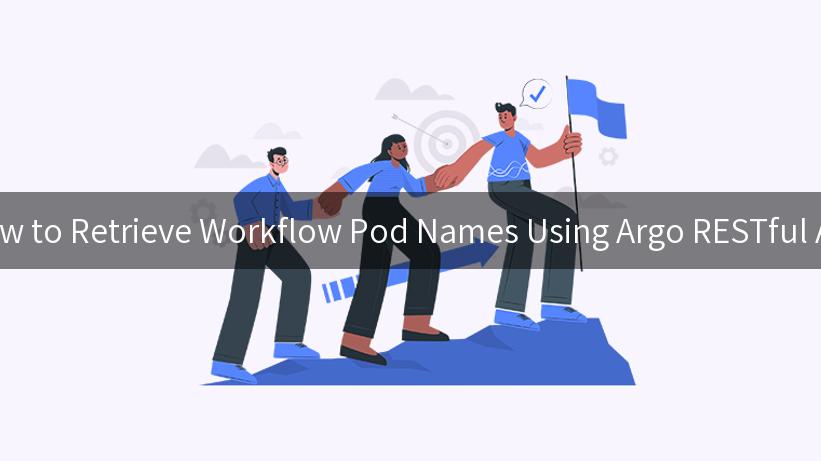
In the ever-evolving world of DevOps and container orchestration, Argo has emerged as a vital tool for managing workflows in Kubernetes. With its robust capabilities, Argo allows developers and operations teams to create, manage, and monitor workflows using a seamless interface. One of the key components in these workflows is the ability to retrieve the names of the pods associated with a certain Argo workflow. In this article, we will dive deep into how to achieve this by utilizing the Argo RESTful API, while also exploring important aspects such as API calls, API governance, and security measures like Basic Identity Authentication and API keys.
Understanding Argo Workflows
Before we jump into the specifics of API calls, let’s take a moment to understand what Argo workflows are. Argo Workflows is an open-source container-native workflow engine for orchestrating parallel jobs on Kubernetes. It allows users to define their workflows as Kubernetes resources, enabling them to seamlessly run and manage tasks at scale.
Why Use Argo RESTful API?
The Argo RESTful API offers programmatic access to the functionality of Argo Workflows. Using this API, users can create workflows, check their statuses, and retrieve details about their associated pods, among other capabilities. This flexibility allows teams to integrate Argo into their existing CI/CD (Continuous Integration/Continuous Deployment) pipelines, thereby enhancing automation and traceability.
Benefits of Using Argo RESTful API:
1. Ease of Access: Allows users to interact with Argo Workflows programmatically.
2. Automation: Enables automation of workflow management tasks.
3. Integration: Facilitates integration with other tools and services in your cloud-native stack.
Prerequisites for Using Argo RESTful API
Before we can retrieve workflow pod names, ensure you have the following prerequisites in place:
- Kubernetes Cluster: You need a running Kubernetes cluster where Argo Workflows is installed.
- Argo Workflows Installed: Make sure Argo Workflows is set up in your cluster.
- Proper Permissions: Your user account must have the necessary permissions to access and interact with the workflows through Argo API.
- Access to API Tokens: Obtain the API key or token needed for authentication.
Authentication and Security
To secure API interactions, it is critical to implement authentication measures. Argo supports two primary methods:
- Basic Identity Authentication: This involves using username and password credentials passed along with each API call.
- API Key: You can configure API keys in your service to authenticate API requests. Always ensure your API keys are kept secure and are not hard-coded in your applications.
Making API Calls to Argo
Now that we have the necessary setup and authentication in place, let’s proceed to make API calls to retrieve workflow pod names. The first step is to ensure you’re able to perform a GET request against the Argo API.
Example API Call to Retrieve Workflow Information
Below is an example of how you can retrieve workflow information using curl. We will utilize this command to obtain the details of a particular workflow, including its associated pod names.
curl --location --request GET 'http://<argo-server>/api/v1/workflows/<namespace>/<workflow-name>' \
--header 'Authorization: Bearer <token>'
Replace <argo-server>, <namespace>, <workflow-name>, and <token> with your actual Argo server address, the Kubernetes namespace where your workflow is running, the name of the workflow, and your Bearer token, respectively.
Retrieving Pod Names from Workflow Information
The response from the API call will return a wealth of information regarding the specified workflow. Here’s a simplified view of the response relevant to retrieving pod names:
{
"metadata": {
"name": "<workflow-name>",
"namespace": "<namespace>"
},
"status": {
"nodes": {
"<node-name>": {
"id": "<node-id>",
"type": "Pod",
"name": "<pod-name>",
"phase": "Succeeded",
...
},
...
}
}
}
To retrieve the pod name, you will want to navigate through the status.nodes object. Here’s how you can extract the pod names from the JSON response with the help of a scripting language like Python.
import requests
url = 'http://<argo-server>/api/v1/workflows/<namespace>/<workflow-name>'
headers = {'Authorization': 'Bearer <token>'}
response = requests.get(url, headers=headers)
workflow_info = response.json()
pod_names = [node['name'] for node in workflow_info['status']['nodes'].values() if node['type'] == 'Pod']
print(pod_names)
Integrating with API Governance
When dealing with APIs, especially in larger organizations or development environments, API governance is a significant consideration. With API governance, organizations can set policies that govern the usage of APIs effectively. This leads to better security, compliance, and efficient resource usage.
Key Aspects of API Governance
- Standardization: Establishing standardized practices for API design, implementation, and documentation.
- Monitoring and Analytics: Keeping track of API usage metrics to identify trends and optimize operations.
- Security Policies: Enforcing security measures such as authentication and rate limiting.
Conclusion
Retrieving workflow pod names using the Argo RESTful API forms an essential aspect of managing workflows effectively within Kubernetes. By employing API calls, you can integrate workflows into your DevOps processes, ensuring better visibility and streamlining tasks. Coupled with sound API governance principles and robust authentication methods like Basic Authentication and API keys, you can ensure your interactions with the Argo API are secure and efficient.
Table of Commands Reference
| Command |
Description |
GET /api/v1/workflows/{namespace}/{workflow-name} |
Retrieve details for a specific Argo workflow. |
curl command |
Use curl to execute the API call with appropriate headers. |
Python script |
Example script to parse JSON response and extract pod names. |
APIPark is a high-performance AI gateway that allows you to securely access the most comprehensive LLM APIs globally on the APIPark platform, including OpenAI, Anthropic, Mistral, Llama2, Google Gemini, and more.Try APIPark now! 👇👇👇
Final Thoughts
The power of Argo and its RESTful API unlocks immense potential for managing cloud-native applications and workflows. As orchestrators of your development lifecycle, understanding how to pull workflow pod names strengthens your capability to monitor and control the deployment lifecycle effectively. Keep experimenting and refining your use of APIs, and harness their full potential to drive innovation in your operational workflows.
By implementing the practices discussed in this article, you will not only retrieve pivotal workflow information but also enhance the overall structure and security of your API interactions. Happy coding!